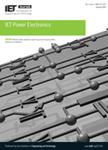版权所有:内蒙古大学图书馆 技术提供:维普资讯• 智图
内蒙古自治区呼和浩特市赛罕区大学西街235号 邮编: 010021

作者机构:Indian Sch Mines Indian Inst Technol Dept Elect Engn Dhanbad 826004 Bihar India
出 版 物:《IET POWER ELECTRONICS》 (IET Power Electron.)
年 卷 期:2018年第11卷第14期
页 面:2355-2366页
核心收录:
基 金:Science and Engineering Research Board (Department of Science and Technology) GOI [YSS/2015/001670]
主 题:model reference adaptive control systems reluctance generators wind power reactive power power generation control brushless machines induction motor drives machine vector control wind power plants angular velocity control asynchronous generators sensorless machine control Popov criterion machine windings active power reactive power variable wind speed drive system wind power application variable speed application wind power generation brushless structure sensorless speed estimation techniques MRAS estimators brushless doubly-fed reluctance generator doubly-fed induction generator model reference adaptive system BDFRG primary field orientation machine secondary winding quantities functional variables Matlab Simulink Popov's criteria hyperstability analysis sensitivity analysis
摘 要:Brushless doubly-fed reluctance generator (BDFRG) is drawing a growing attention of research over the traditional doubly-fed induction generator in variable speed application like wind power generation nowadays, due to its brushless structure. In this work, the applicability of different model reference adaptive system (MRAS) based sensorless speed estimation techniques for BDFRG in wind power application is explored. The MRAS estimators developed, in this context, are based on active power, reactive power and fictitious quantity. All these schemes are implemented under primary field orientation using machine secondary winding quantities as the functional variables. Matlab/Simulink study and hardware test results under variable wind speed (between cut-in and rated speed) are presented for the aforementioned speed estimation techniques. Furthermore, to ensure the robustness of the drive system, stability study using Popov s criteria for hyperstability and sensitivity analyses is presented.